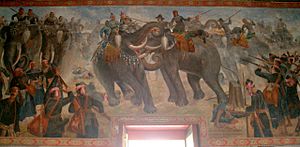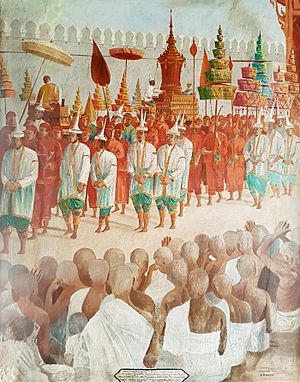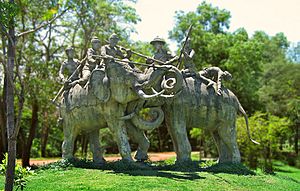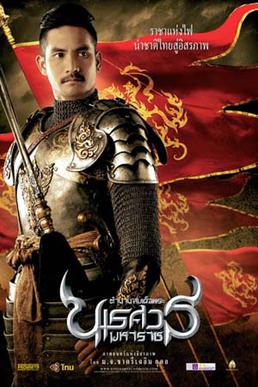Naresuan facts for kids
Quick facts for kids Naresuan the Greatนเรศวรมหาราช |
|
|---|---|
| King of Ayutthaya | |
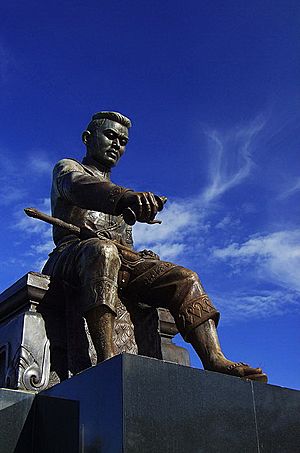
Statue of King Naresuan pouring water on the ground, symbolizing declaration of independence from the Burmese Taungoo Empire, at Naresuan University.
|
|
| King of Siam | |
| Reign | 1 July 1590 – 25 April 1605 |
| Predecessor | Mahathammarachathirat |
| Successor | Ekathotsarot |
| Born | 1555-1556, 917 CS Chan Palace, Phitsanulok, Sukhothai Kingdom |
| Died | 25 April 1605 (aged 48-50) Monday, 8th waxing of Sixth Siamese month (Vaisakha), 967 CS Lan Na |
| Spouse | Mani Rattana Ek Kasattri Yodaya Mibaya |
| House | Sukhothai Dynasty |
| Father | Mahathammarachathirat |
| Mother | Wisutkasat |
King Naresuan (also known as Sanphet II) was a powerful ruler of the Ayutthaya Kingdom in Thailand. He was the 18th king of Ayutthaya and the second king from the Sukhothai dynasty. He ruled from 1590 until his death in 1605. Naresuan is famous for leading his people to freedom from the control of the Taungoo Empire (Burma). During his time as king, he fought many wars against Burma and also welcomed traders from the Netherlands.
Contents
Who Was King Naresuan?
Naresuan's Early Life
Prince Naret, also called the "Black Prince," was born in Phitsanulok around 1555–1556. His father was King Mahathammarachathirat of Phitsanulok, and his mother was Queen Wisutkasat. His mother was the daughter of King Maha Chakkraphat and Queen Suriyothai. Prince Naret had a younger brother, Ekathotsarot, known as the "White Prince," and an older sister, Suphankanlaya.
Becoming a Hostage
During a war in 1563–1564, King Bayinnaung of the Toungoo dynasty from Burma attacked Thailand. He laid siege to Phitsanulok. Prince Naret's father, Maha Thammarachathirat, surrendered because the city was running out of food and people were getting sick. King Bayinnaung took control of Phitsanulok and Ayutthaya, making Thailand a state that had to pay tribute to Burma. To make sure Maha Thammarachathirat stayed loyal, King Bayinnaung took Prince Naret to Burma as a royal hostage.
Life in Burma
Prince Naret spent about six years in Bago, Burma. Around 1570, he and his brother returned to Ayutthaya. While in Burma, he received excellent military training. He studied alongside the sons of Burmese princes and nobles. Naresuan was very smart and learned a lot about military strategies and general knowledge of the time.
Naresuan Becomes Crown Prince

When Prince Naret was 15, his father made him the Uparaja (crown prince) of Phitsanulok. He was then known as Naresuan.
Naresuan joined his father and the King of Bago on a trip to conquer Vientiane. However, he got smallpox and had to go back. He built Chankasem Palace in Ayutthaya to stay in when he visited his parents.
Declaring Independence
In 1581, King Bayinnaung died, and his son Nanda Bayin became the new king. In 1583, Nanda Bayin's uncle rebelled. Nanda Bayin asked for help from different regions, including Ayutthaya. On February 2, 1584, Naresuan left with his soldiers for Bago as ordered.
Naresuan reached a border town called Kraeng. There, he learned that Nanda Bayin's son planned to attack him from both the front and the back. Naresuan held a meeting with his advisors and some Mon people. During this meeting, Naresuan performed a special ceremony. He poured water on the ground from a gold cup. This was a way to declare to the gods and everyone present that from that day on, Siam (Thailand) was no longer friends with Burma and was now independent.
Naresuan then gathered the Mon people to join his army. He marched towards Bago to free the Siamese families held there. However, Nanda Bayin had already defeated the rebel and was returning to his capital. Naresuan decided to retreat after freeing about 10,000 families.
Battles for Freedom
The Burmese army, led by Mingyi Swa, chased Naresuan. The two armies met at the Satong River. During the fight, a Burmese general named Surakamma was killed by a shot from Naresuan's royal gun as Naresuan crossed the river. This caused the Burmese troops to panic and retreat.
Naresuan then held a "swearing allegiance" ceremony with the people of Sukhothai. His forces also took control of Sawankhalok. In 1584, Naresuan moved all the men from the northern provinces to Ayutthaya to prepare for more attacks from Burma.
Nanda Bayin sent two more armies to attack Siam, but Naresuan defeated both of them. In 1586, Naresuan defeated the Viceroy of Chiang Mai, capturing many soldiers, elephants, horses, and supplies.
In October 1586, Nanda Bayin himself led the Burmese army to Ayutthaya. They surrounded the city for five months, but Naresuan's strong defense prevented them from taking it. Nanda Bayin eventually retreated.
In 1590, Naresuan's father, Maha Thammarachathirat, died. In July 1590, Naresuan was crowned King of Ayutthaya as Sanphet II.
The Burmese army, led by Phra Maha Uparat, attacked Siam again. Naresuan defeated them near Ban Khoi, and the Burmese army retreated, losing many soldiers and supplies.
King Naresuan's Reign
The Famous Elephant Battle
King Naresuan is well-known in Thailand for his elephant duel in 1593 with the Burmese Crown Prince Mingyi Swa. While other historical records mention an elephant battle, only some Thai accounts describe a formal duel.
The Thai Story of the Duel
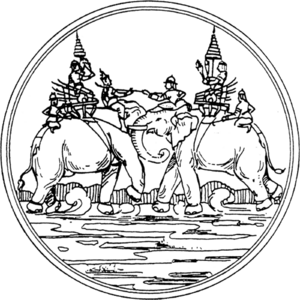
In November 1592, Nanda Bayin ordered his son, Mingyi Swa, to attack Ayutthaya again. Mingyi Swa led one of three Burmese divisions. Naresuan had been planning to attack Cambodia, but he changed his plans to face the Burmese threat. Naresuan marched towards Suphan Buri and set up his army at Nong Sarai. His battle plan involved a fake retreat to make the Burmese follow, then attacking their disorganized advance with his main army.
During the battle in January 1593, Naresuan's war elephant, Chaophraya Chaiyanuphap, and his brother Ekathotsarot's elephant, Chaophraya Prap Traichak, became very excited and charged into the middle of the Burmese army. Only a few Siamese soldiers could follow them. According to one story, Naresuan saw Mingyi Swa on his elephant under a tree. Naresuan shouted, "My brother, why are you staying under the shade of a tree? Why not come out and fight me in single combat? It would be an honor for us, as no kings in the future will fight like this."
The personal fight between Naresuan and Mingyi Swa is a very famous and romanticized historical event known as the "Elephant Battle" (สงครามยุทธหัตถี).
After a long duel, Mingyi Swa narrowly missed Naresuan but cut his helmet. Naresuan then used his ngao (a type of glaive) to cut Mingyi Swa. Prince Somdet Phra Ekathotsarot also killed the governor of Muang Chacharo. The main Siamese army then arrived, and the Burmese were defeated and scattered. The King of Bago ordered his other two divisions to retreat.
Naresuan's ngao, named Chao Phraya Prap Hongsawadi (meaning "Chao Phraya which defeated Bago"), and his helmet, Chao Phraya Sen Phonlaphai (meaning "Chao Phraya which defeated a hundred thousand soldiers"), are said to still exist today. Naresuan built a pagoda at the site of the elephant battle to celebrate his victory.
Naresuan was angry with the commanders who couldn't follow him into the battle. He wanted to punish them with death. However, a respected monk, Somdet Phra Phanarat, calmed Naresuan. Instead of death, the commanders were ordered to capture the cities of Dawei and Tanintharyi to make up for their mistake.
Other Views on the Battle
Burmese historical records do not mention a formal duel. They state that the two armies fought on January 8, 1593, and Mingyi Swa was killed by a shot from a Siamese gun. There are ten different accounts of this battle from various sources. Only one Thai account mentions a formal elephant duel. However, Jeremias van Vliet, who wrote about Siam in the 1630s, interviewed Siamese people who lived during Naresuan's time. They insisted that the elephant combat, where the Burmese crown prince died by Naresuan's hand, did happen.
According to Van Vliet's book, the Pegu prince and the young Siamese prince, both on elephants, lost control and attacked each other fiercely. The Siamese prince killed his opponent with his lance.
Some historians believe it's unlikely that Mingyi Swa would have agreed to a formal duel, as it would have risked the entire invasion. They suggest that during the battle, Naresuan's elephant became surrounded by Burmese forces. At that moment, a Burmese war elephant went wild and attacked Mingyi Swa's elephant. Seeing Mingyi Swa in trouble, Naresuan moved in and fired a gun, which fatally wounded the crown prince. Naresuan was lucky to escape a dangerous situation and quick to take advantage of it. Many historians now believe the story of Naresuan's challenge for a duel is more of a legend.
Expanding the Kingdom
Capturing Dawei and Tanintharyi
In 1593, Naresuan sent his generals to attack Tanintharyi and Dawei, which were Mon cities. They captured both cities after short sieges. The Burmese king sent a fleet to defend these cities, but they arrived too late and were defeated by the Thai fleet. A Burmese land force was also ambushed and defeated by the Thai army, leading to the capture of many Burmese commanders and supplies.
Conquering Cambodia
In 1593, Naresuan also successfully led a campaign to conquer Cambodia. He brought Khmer families to live in his northern provinces.
Taking Mottama
As Burmese control weakened, the Mon people decided to fight for their freedom. The Mon governor of Mawlamyine rebelled against Burma and asked for help from Siam. Naresuan sent troops, and the Burmese abandoned their base at Martaban. The Mon provinces then became part of the Siamese Kingdom.
Attacking Burma's Capital
Naresuan decided to attack Bago, the Burmese capital, in 1595. He surrounded the city for three months. However, he retreated when other Burmese leaders sent forces to help. Naresuan did manage to take many prisoners of war, which weakened the Burmese army.
After many rebellions within the Burmese Empire, Naresuan decided to attack Bago again in 1599. He planned to work with allies from Arakan and Taungoo. But before Naresuan arrived, the forces of Arakan and Taungoo had already taken the city. The leader of Taungoo took the people back to Taungoo, leaving the city for Arakan's forces to loot. They then burned the palace and temples.
Naresuan occupied Bago, but the Viceroy of Taungoo had already taken the Burmese King Nanda Bayin to Taungoo. Naresuan asked for Nanda Bayin to be returned, but the Viceroy refused. Naresuan then surrounded Taungoo for two months but had to retreat because his army ran out of food.
The Death of King Naresuan
Nanda Bayin was killed while held captive in Toungoo. A new king, Nyaungyan Min, crowned himself King of Ava. Siam was free from Burmese threats for four years. Then, the King of Ava began to conquer the Shan States. When he reached Theinni, Naresuan gathered a large army of 200,000 men to stop this threat to his kingdom. He marched as far as the Fang District of Chiang Mai Province. There, he became ill and died three days later, on April 25, 1605. His brother, King Ekathotsarot, became the next king.
Recent studies of Burmese records suggest that Naresuan returned to Wiang Haeng, where he died of a disease, possibly smallpox. Many Shan people believe King Naresuan was cremated and his ashes were placed in a stupa (a monument) in Mongton, in the southern part of the Shan State.
King Naresuan's Legacy
Historians remember Naresuan as a brave and glorious king. During his reign, the Kingdom of Siam was at its largest and most powerful.
- Thai Baht Banknotes:
- His image appeared on the 100 baht note (series 12) to honor great Thai monarchs.
- He is also on the 50 baht note (series 16) which celebrates Thai kings from different periods.
- Royal Thai Armed Forces Day: January 18 is a national holiday in Thailand that celebrates his victory in the 1593 elephant duel.
- HTMS Naresuan: A Royal Thai Navy frigate (a type of warship) is named after him.
- Naresuan University: A university in Phitsanulok is named after the king and has a large statue of him.
- Naresuan Dam: One of the largest dams in Phitsanulok Province is named after him. It controls the water flow of the Nan River.
- Thung Yai Naresuan Wildlife Sanctuary: This is Thailand's largest wildlife conservation area.
King Naresuan in Media
- King Naresuan — a series of films from 2007 based on the king's life.
- Khan Kluay — a 2006 animated Thai film about the king's war elephant, followed by a sequel Khan Kluay 2.
- King Naresuan Online — a fantasy online role-playing game released in 2010.
- Civilization V — a PC game from 2010 where Siam has a special unit called "Naresuan's Elephant."
- The Legend of King Naresuan: The Series — a television series that started in 2017.
See also
 In Spanish: Naresuan para niños
In Spanish: Naresuan para niños


